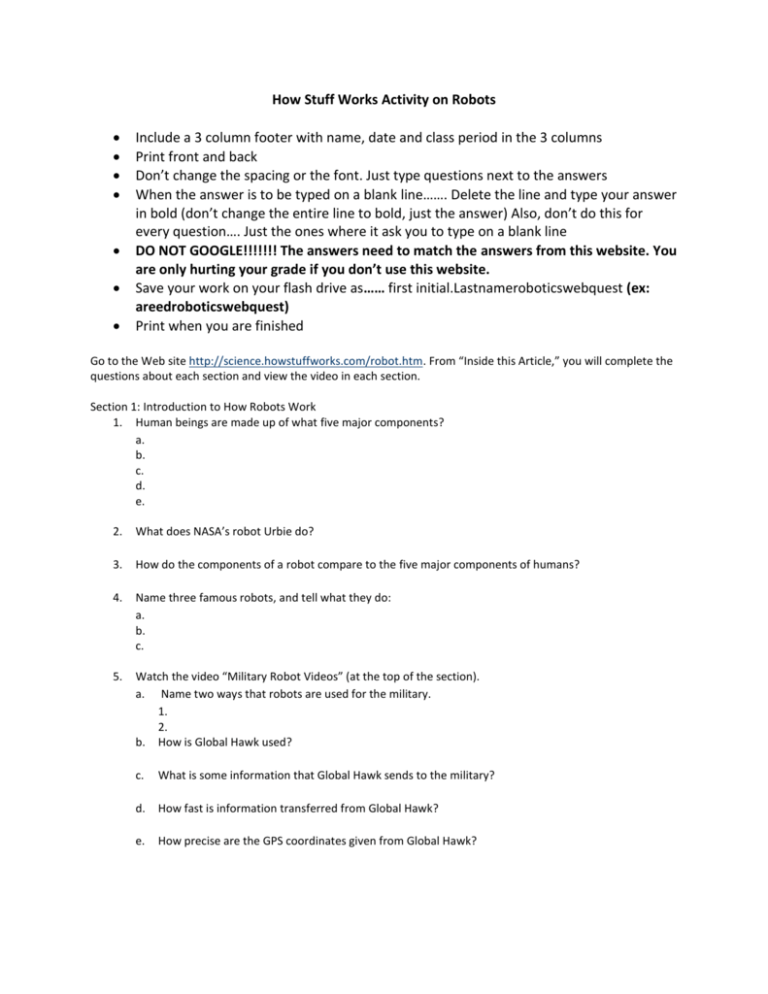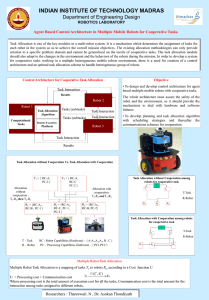How Stuff Works Activity on Robots Include a 3 column footer with
advertisement

How Stuff Works Activity on Robots Include a 3 column footer with name, date and class period in the 3 columns Print front and back Don’t change the spacing or the font. Just type questions next to the answers When the answer is to be typed on a blank line……. Delete the line and type your answer in bold (don’t change the entire line to bold, just the answer) Also, don’t do this for every question…. Just the ones where it ask you to type on a blank line DO NOT GOOGLE!!!!!!! The answers need to match the answers from this website. You are only hurting your grade if you don’t use this website. Save your work on your flash drive as…… first initial.Lastnameroboticswebquest (ex: areedroboticswebquest) Print when you are finished Go to the Web site http://science.howstuffworks.com/robot.htm. From “Inside this Article,” you will complete the questions about each section and view the video in each section. Section 1: Introduction to How Robots Work 1. Human beings are made up of what five major components? a. b. c. d. e. 2. What does NASA’s robot Urbie do? 3. How do the components of a robot compare to the five major components of humans? 4. Name three famous robots, and tell what they do: a. b. c. 5. Watch the video “Military Robot Videos” (at the top of the section). a. Name two ways that robots are used for the military. 1. 2. b. How is Global Hawk used? c. What is some information that Global Hawk sends to the military? d. How fast is information transferred from Global Hawk? e. How precise are the GPS coordinates given from Global Hawk? Section 2: Robotic Basics 1. What is a quality that most robots have in common? 2. Robots spin wheels and pivot jointed segments with an _______________________. 3. 4. The robot’s __________________________controls everything attached to the circuit. Most robots are reprogrammable. What does reprogrammable mean? 5. The most common robot sense is ____________________________. Section 3: The Robotic Arm 1. What word is “robot” derived from, and what is it translated as? 2. What are most robots in the world designed for? 3. What is the most common manufacturing robot, and what is it made up of? 4. What kinds of sensors are used to make sure the robot moves just right? 5. What does “six degrees of freedom” mean? 6. What do pressure sensors tell the computer about the robot? 7. Where do most industrial robots work? Section 4: Mobile Robots 1. What was NASA’s FIDO Rover designed to do? 2. If the robot is moving on smooth ground, then the best locomotion system to use is ____________ or ______________________. 3. What moves robot legs back and forth? 4. Remote robots are useful for exploring dangerous areas of the environment such as the ____________ ______________ or _______________________. 5. Watch the video “Danger Robots.” a. How are robots used in dangerous situations? b. What are some “creatures/animals” that Rex imitates? c. What animal are they studying to help develop a robot to climb? Section 5: Autonomous Robots 1. What are autonomous robots? 2. Which robot is a good example of this? 3. Who uses Urbie and for what? 4. Simpler robots use what kinds of sensors to see obstacles? 5. Watch the video “Bombat: The Military Robot” (at the top of the section). a. Where is Bombat used and for what? b. Who uses Bombat II, and what is it used for? Section 6: Homebrew Robots 1. What are homebrew robots? 2. From the video “Household Robots,” describe Domo. 3. What does the robot “Stare” do? 4. How may this help elderly people? Click on “See More” to get to the following sections: Section 7: Robotics and Artificial Intelligence 1. What is artificial intelligence (AI)? 2. This includes the ability to: a. b. c. d. 3. The real challenge of AI is to understand how what works?




